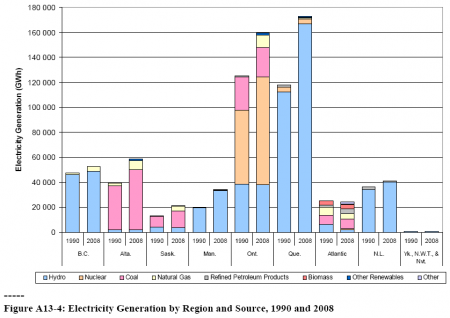As discussed before, one reason why it is so challenging politically to put a price on carbon is because there is large regional disparity in how energy is produced.
This chart – taken from part three of Canada’s latest National Inventory Report to the UNFCCC – shows how each province generates its electricity:
Clearly, it is easier for some provinces to make use of low-carbon options like hydroelectricity than it is for others. Also, much of that hydro capacity was built before policy-makers were seriously concerned about climate change.
That being said, the science is now very clear and the period in which people can justifiably claim ignorance about the climatic consequences of their actions is over. Places that made their energy choices before humanity was aware of all the implications of climate change can make a legitimate case for some adjustment time. That said, the defence of ignorance no longer holds and the clock on that adjustment time is ticking.


Is the science on the carbon-friendliness of hydro power settled? Granted any carbon which will continue to be released from reservoirs is beyond our control in a way unlike carbon to be released from the burning of coal – but whether dam reservoirs actually emit more or less carbon than an equivalent coal plant remains an important piece of information when considering building new hydro projects.
Dams and climate change
The consensus seems to be that dams emit less, at least if biomass clearing is undertaken, but not catastrophically less. Perhaps we should be concentrating on zero-emissions rather than reduced-emissions forms of electricity production. If dams simply produce “less” Co2 than coal – they aren’t fundamentally different from natural gas power plants.
This graph is actually a bit strange – it seems to express the total energy generated by each province in gigawatt hours, over 10 years. What would be more useful would be a graph showing the breakdown of their capacity, and how much of that capacity is used during off and peak hours.
Building a dam releases some CO2 at the time of construction, but it is a one-off. Coal plants must produce CO2 for every kilowatt-hour of energy generated.
It would be good to build dams in more low-carbon ways, but hydro is ultimately an absolutely key form of renewable energy.
“Building a dam releases some CO2 at the time of construction, but it is a one-off.”
This isn’t even close to true. If you read the literature Milan has provided links to, you’ll find that hydro projects are better than coal in the long term in non-tropical regions, at least if the forests are cleared. But even with the forests cleared there is co2 released from the rotting biomass (soil) for decades. In tropical regions there is so much vegetation that the emissions are many times worse than a coal plant, even in the medium to long term. I’m amazed at how uneducated we remain on the subject of CO2 release from hydro projects. It’s almost as if there is a taboo against talking about it.
A one-off that takes decades is still a one-off.
Big dams can keep producing power for as long as there is sunlight and gravity.
That’s really false, and demonstrates an important bias which is about to become a major financial problem – concrete doesn’t last forever. Dams have a lifespan, I don’t know exactly what it is, but I doubt it’s more than a few hundred years. Just like all concrete infrastructure has a lifespan – and it’s not obvious that we’ll be able to maintain our current concrete infrastructure (largely built in the 60s) through the next 30 or 50 years.
Now, not all dams are concrete, but I don’t think earthen dams last forever either. Certainly they might not survive major geological events, which do happen every so often.
The time-scale of CO2 release from dams is not decades, but centuries. The extremely problematic Brazilian project will still be producing more CO2 than the fossil fueled equivalent in a hundred years – and I first found out about that when I was still an undergraduate.
Thank you for providing these charts which was an easy way to see the electricity sources for each province. I had not realized the variability or the extent of nuclear power in Ontario.
Dams don’t last forever, but I do think they will play an important role in climate change mitigation. Indeed, pumped hydroelectric storage could play an important role in balancing output from variable sources with demand.
I think we previously calculated that big dams are a good low-carbon option. Comparing them to coal or gas plants seems inaccurate.